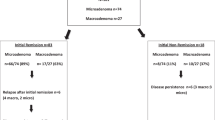Abstract
Background
Surgery is currently the first-line treatment of Cushing’s disease. Surgery for Cushing’s patients requires technical specificity, especially if no adenoma is identified on dedicated preoperative pituitary MRI.
Method
From 2006 to 2020, 683 patients with Cushing’s disease were operated on with a mononostril endoscopic endonasal approach by the same two senior neurosurgeons. Here, we report the particularities of this challenging surgery.
Conclusion
A rigorous and planned surgical strategy avoids the pitfalls of Cushing’s disease surgery and leads to a high rate of endocrine remission.



Similar content being viewed by others
References
Andereggen L, Mariani L, Beck J, Andres RH, Gralla J, Luedi MM, Weis J, Christ E (2021) Lateral one-third gland resection in Cushing patients with failed adenoma identification leads to low remission rates: long-term observations from a small, single-center cohort. Acta Neurochir (Wien). https://doi.org/10.1007/s00701-021-04830-2
Baussart B, Declerck A, Gaillard S (2021) Mononostril endoscopic endonasal approach for pituitary surgery. Acta Neurochir (Wien) 163(3):655–659
Biller BMK, Grossman AB, Stewart PM et al (2008) Treatment of adrenocorticotropin-dependent Cushing’s syndrome: a consensus statement. J Clin Endocrinol Metab 93(7):2454–2462
Carr SB, Kleinschmidt-DeMasters BK, Kerr JM, Kiseljak-Vassiliades K, Wierman ME, Lillehei KO (2018) Negative surgical exploration in patients with Cushing’s disease: benefit of two-thirds gland resection on remission rate and a review of the literature. J Neurosurg 129(5):1260–1267
Cebula H, Baussart B, Villa C et al (2017) Efficacy of endoscopic endonasal transsphenoidal surgery for Cushing’s disease in 230 patients with positive and negative MRI. Acta Neurochir (Wien) 159(7):1227–1236
Chandler WF, Barkan AL, Hollon T, Sakharova A, Sack J, Brahma B, Schteingart DE (2016) Outcome of transsphenoidal surgery for cushing disease: a single-center experience over 32 years. Neurosurgery 78(2):216–223
Ciric I, Zhao J-C, Du H, Findling JW, Molitch ME, Weiss RE, Refetoff S, Kerr WD, Meyer J (2012) Transsphenoidal surgery for Cushing disease: experience with 136 patients. Neurosurgery 70(1):70–80; discussion 80–81
Prevedello DM, Pouratian N, Sherman J, Jane JA, Vance ML, Lopes MB, Laws ER (2008) Management of Cushing’s disease: outcome in patients with microadenoma detected on pituitary magnetic resonance imaging. J Neurosurg 109(4):751–759
Toro MDC, Serrano TLI, Marson FAL, Chone CT, Dal Fabbro M, Sakano E, Sampaio MH (2020) Comparative analysis of rhinologic outcomes in Cushing disease and non-functioning pituitary adenoma in patients submitted to endoscopic endonasal transsphenoidal surgery. Eur Arch Otorhinolaryngol 277(8):2371–2374
Weil RJ, Vortmeyer AO, Nieman LK, Devroom HL, Wanebo J, Oldfield EH (2006) Surgical remission of pituitary adenomas confined to the neurohypophysis in Cushing’s disease. J Clin Endocrinol Metab 91(7):2656–2664
Author information
Authors and Affiliations
Corresponding author
Ethics declarations
Ethics approval
All procedures performed in studies involving human participants were in accordance with the ethical standards of the institutional and/or national research committee and with the 1964 Helsinki declaration and its later amendments or comparable ethical standards.
Conflict of interest
The authors declare no competing interests.
Additional information
Key Points
1. Current guidelines still consider pituitary surgery as the first-line treatment of Cushing’s disease.
2. No pituitary surgery should be decided until Cushing’s disease has been assessed by a referent endocrinologist.
3. A venous bleeding is usually observed, explained by the specific mucosal fragility and increased intracranial pressure due to obesity.
4. Optimal positioning with a more sitting position and anaesthetic protocol are crucial to limit mucosal venous bleeding.
5. The sphenoid rostrum is the most consistent median anatomical landmark.
6. In conchal-type sphenoid sinus, we recommend a centrifugal drilling of the sellar floor under neuronavigation.
7. Sellar and dural opening should expose the entire pituitary gland.
8. In case of an obvious lateralization on preoperative inferior petrosal or cavernous sinus samplings, the pituitary exploration starts on the suspect side.
9. Well-circumscribed adenomas are removed with a selective adenomectomy, poorly circumscribed adenomas are removed with an enlarged adenomectomy.
10. If no adenoma is identified, a partial anterior and posterior hypophysectomy including the inferior third of the pituitary gland is performed.
Publisher's note
Springer Nature remains neutral with regard to jurisdictional claims in published maps and institutional affiliations.
This article is part of the Topical Collection on Pituitaries
Supplementary Information
Below is the link to the electronic supplementary material.
Supplementary file1 (MP4 245843 KB)
Rights and permissions
About this article
Cite this article
Baussart, B., Gaillard, S. Pituitary surgery for Cushing’s disease. Acta Neurochir 163, 3155–3159 (2021). https://doi.org/10.1007/s00701-021-04995-w
Received:
Accepted:
Published:
Issue Date:
DOI: https://doi.org/10.1007/s00701-021-04995-w




